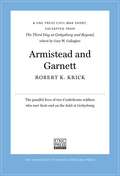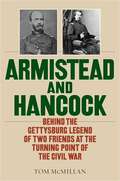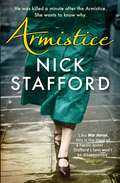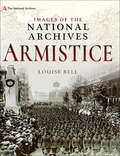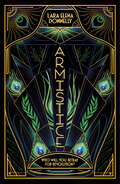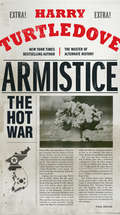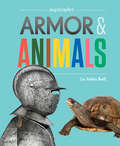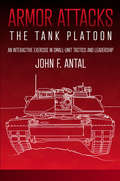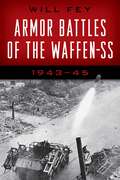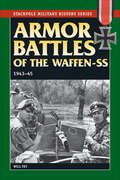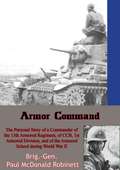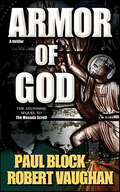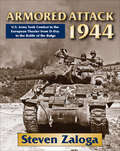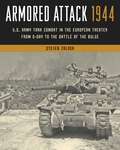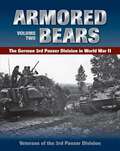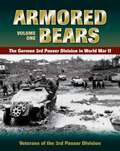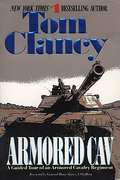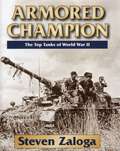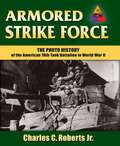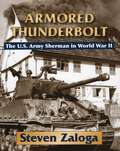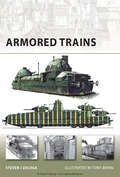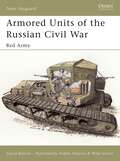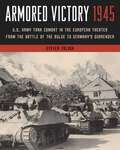- Table View
- List View
Armistead and Garnett
by Robert K. KrickVirginians Lewis A. Armistead and Richard B. Garnett, two Confederate officers killed during Pickett's Charge at Gettysburg, lived remarkably parallel lives. In this Civil War Short, Robert K. Krick follows the two men from their early military careers fighting against American Indians and Mormons through two decades of military service and onto the field at Gettysburg, where both were mortally wounded. The work was originally published in The Third Day at Gettysburg and Beyond, edited by Gary W. Gallagher, which combines fresh evidence with the reinterpretation of standard sources to testify to the enduring impact of the Civil War on our national consciousness and refocus our view of the third day at Gettysburg. UNC Press Civil War Shorts excerpt rousing narratives from distinguished books published by the University of North Carolina Press on the military, political, social, and cultural history of the Civil War era. Produced exclusively in ebook format, they focus on pivotal moments and figures and are intended to provide a concise introduction, stir the imagination, and encourage further exploration of the topic. For in-depth analysis, contextualization, and perspective, we invite readers to consider the original publications from which these works are drawn.
Armistead and Hancock: Behind the Gettysburg Legend of Two Friends at the Turning Point of the Civil War
by Tom McMillanIn a war of brother versus brother, theirs has become the most famous broken friendship: Union general Winfield Scott Hancock and Confederate general Lewis Armistead. Michael Shaara&’s The Killer Angels (1974) and the movie Gettysburg (1993), based on the novel, presented a close friendship sundered by war, but history reveals something different from the legend that holds up Hancock and Armistead as sentimental symbols of a nation torn apart.In this deeply researched book, Tom McMillan sets the record straight. Even if their relationship wasn&’t as close as the legend has it, Hancock and Armistead knew each other well before the Civil War. Armistead was seven years older, but in a small prewar army where everyone seemed to know everyone else, Hancock and Armistead crossed paths at a fort in Indian Territory before the Mexican War and then served together in California, becoming friends—and they emotionally parted ways when the Civil War broke out. Their lives wouldn&’t intersect again until Gettysburg, when they faced each other during Pickett&’s Charge. Armistead died of his wounds at Gettysburg on July 5, 1863; Hancock went on to be the Democratic nominee for president in 1880, losing to James Garfield.Part dual biography and part Civil War history, Armistead and Hancock: Behind the Gettysburg Legend clarifies the historic record with new information and fresh perspective, reversing decades of misconceptions about an amazing story of two friends that has defined the Civil War.
Armistice
by Nick StaffordPhilomena Bligh's fiancé, Dan, has been shot. The First World War claimed many lives and so his death is not, in its own way, surprising. But Dan was shot in the minutes after the Armistice. The war was over.She cannot understand how this could have happened, or why they were still fighting that morning anyway. So, in March 1919, over Dan's birthday, Philomena travels to London to meet the men who were with him when he died. What she discovers is more shocking than she'd ever imagined. Dan's best friend, Jonathan, tells her that Dan was shot by a British officer over a gambling debt. There is no proof and all records of Jonathan's accusation have been destroyed.Refusing to accept anything less than justice for the man she loved, Philomena decides to take on the Establishment. Worried that she may cause his own downfall and feeling guilty for his mysterious part in Dan's death, Jonathan decides to accompany her on her mission.Set against a backdrop of London in the aftermath of the Great War, a time of upheaval, grief and wanton escapism, this is not just an inspirational book about what it means to be a hero, but also a breathtaking love story.
Armistice: Armistice (Images of the National Archives)
by Louise Bell11th November 1918 saw the signing of the armistice that ended fighting between the Allies and Germany.This book will take the reader through the final year of the First World War and everything that led up to this day. Starting from the Spring Offensive, photos and images from The National Archives will highlight important points ranging from the last 100 days to the signing of the various treaties before this final armistice, finishing with a look at the Peace Parade in 1919. The physical and mental effects of the war will also be examined, and show how the war never really ended in 1918 for many.Many rarely seen images will be provided to support the narrative and further highlight the depth of The National Archives' First World War records.
Armistice: Book 2 In The Amberlough Dossier (Amberlough Dossier #2)
by Lara Elena DonnellyArmistice returns to Donnelly’s ravishing 1930s Art Deco-tinged fantasy world of the Nebula and Lambda Award-nominated Amberlough with a decadent, tumultuous mixture of sex, politics, and spies“A hefty novel full of fascinating characters exploring oversized topics such as sexuality, music, culture, fascism, nationalism, class wars, revolution and love.” —Shelf AwarenessIn a tropical country where shadowy political affairs lurk behind the scenes of its glamorous film industry, three people maneuver inside a high stakes game of statecraft and espionage: Lillian, a reluctant diplomat serving a fascist nation,Aristide, an expatriate film director running from lost love and a criminal past,—and Cordelia, a former cabaret stripper turned legendary revolutionary. Each one harbors dangerous knowledge that can upturn a nation. When their fates collide, machinations are put into play, unexpected alliances are built, and long-held secrets are exposed. Everything is barreling towards an international revolt...and only the wiliest ones will be prepared for what comes next.For Amberlough: “James Bond by way of Oscar Wilde.”—Holly Black“Astonishing!” —World Fantasy Award-winning author Ellen Kushner“Beautiful, all too real, and full of pain. Read it. It will change you.” —Hugo Award-winning author Mary Robinette KowalAt the Publisher's request, this title is being sold without Digital Rights Management Software (DRM) applied.
Armistice: The Hot War (The Hot War #3)
by Harry TurtledoveIn the final book of the blistering trilogy The Hot War, old hatreds and new chances for revenge are unleashed on an already devastated world—as the Cold War becomes a roaring inferno.In 1952 American cities lie in ruins. President Harry Truman, in office since 1945, presides over a makeshift government in Philadelphia, suffering his own personal loss and fearing for the future of democracy. In the wake of Hitler’s reign, Germany and America have become allies, and Stalin’s vise hold on power in the USSR persists. Unwilling to trust the Soviet tyrant, Truman launches a long-planned nuclear strike on the city of Omsk—killing Stalin and plunging the Red Army into leaderless, destructive anarchy. Meanwhile, the Baltic states careen toward rebellion, and Poland is seized by rebels bred on war. In a world awash with victims turned victors, refugees, and killers, has Truman struck a blow for peace or fueled more chaos? As these staggering events unfold, the lives of men and women across battle lines, ethnicities, and religions play out across the globe. In Los Angeles, an extended Jewish family builds a future, while the foul smell of a refugee camp in Santa Monica blows in on the ocean breeze. In Korea, a U.S. fighter struggles to bring his Korean interpreter stateside as a full American. In Siberia, two German women fight for their survival in a gulag—and begin a strange, harrowing journey home. From the terrifying global chess match between superpowers to the strength of individual human conscience, Armistice captures a world that’s been split to its core by the violence only mankind can create. Through the thunder of battle, the clashes of armies, and the whispers of lovers, how humanity will be rebuilt, and who will do it, are the questions that resound in this marvelous work of imagination and history. PRAISE FOR HARRY TURTLEDOVE “Turtledove is the standard-bearer for alternate history.”—USA Today Fallout “No one writes alternate-history novels quite like Turtledove. . . . Expect epic political stakes as well as personal and heartfelt stories of war.”—BookTrib Bombs Away “Turtledove’s thorough research and grounded imagination work to create a frighteningly realistic past where world leaders act out of desperation and fatalism and a large cast of common folk suffer the consequences. . . . The vicarious sense of eschatological dread is always powerful.”—Booklist Last Orders “All quite plausible . . . Turtledove’s focus on the characters serves to fill out the big picture with patient, nitty-gritty detail. . . . Armchair warriors will have much to ponder.”—Kirkus Reviews Two Fronts “A you-are-there chronicle of battle on land and sea and in the air.”—Tor.com
Armor & Animals
by Liz Yohlin BaillWhat do knights in shining armor have to do with slimy snails and porcupines? A lot, actually! Armor & Animals brings together two things kids love to provide an entryway into the world of art. The armor collection at the Philadelphia Museum of Art, beloved by its young visitors, provides the remarkable helmets, shields, and more that appear in the book, and which experienced museum educator Liz Yohlin Baill compares to the shells, scales, and spikes that protect animals.Lively text paired with bright, modern graphics and real-life armor informs kids about art and animals in tandem. A rhino crashes into a knight, teaching kids that a group of rhinos is called a crash—so stay out of the way! Dragons may be imaginary, but a fire-breathing dragon etched on armor can still make a horse look extra tough. Kids can consider the helmets, goggles, and other "armor" they use that help make their own activities safer, and connect art to their world as they learn.
Armor Attacks: An Interactive Exercise in Small-unit Tactics and Leadership
by John F. Antal“Extremely clever . . . part tactical decision game (TDG), part combat adventure page turner, and part The Defense of Duffer’s Drift.” —Capt. Randall P. Newman, USMCIn this unique, interactive story, you are the leader of a U.S. Army M1 Abrams tank platoon. Throughout the text, you’ll have an opportunity to make life-or-death decisions, and the events that unfold will be dictated by the choices you make. As you progress through the book, you’ll learn important tactical and operational lessons. Whether or not you are—or want to be—a tank platoon leader, you’ll find this book both highly entertaining and instructive.There are two operations to survive—an assault and a counter-reconnaissance mission. In each you must bring your knowledge and judgment to bear on the scenario in order to achieve the objective. If you choose wrong, defeat and even death may be your fate. If you succeed, you can savor the taste of victory and live to fight another day. The scenarios are highly realistic, and there are maps and appendices with detailed specifications of the hardware involved to help you make informed decisions.Written before Operation Desert Storm and published in 1991, Armor Attacks may feature military technology that’s dated by today’s standards—but the need for human leadership and effective, rapid decision-making has not changed. Armor Attacks was recognized as an invaluable teaching tool by United States Military Academy, West Point and was used to teach cadets the essential skills of leadership, decision-making, and tactics—a decade of USMA leaders trained with this book. To supplement the original text, this new edition includes the West Point instructor reference guide, which explains and amplifies the teaching points of each scenario encountered.
Armor Battles of the Waffen-SS: 1943–45
by Will FeyThe Waffen-SS were considered the elite of the German armed forces in the Second World War and were involved in almost continuous combat. From the sweeping tank battle of Kursk on the Russian front to the bitter fighting among the hedgerows of Normandy and the last great offensive in the Ardennes, forever immortalized in history as the Battle of the Bulge, these men and their tanks made history.
Armor Battles of the Waffen-SS: 1943–45 (Stackpole Military History Series)
by Will FeyThis German WWII military history offers an in-depth view of armored combat across Europe from the perspective of the Waffen SS. The Waffen SS were considered the elite of the German armed forces in the Second World War and were involved in almost continuous combat. In this volume, a former Waffen SS captain offers an in-depth account of their armored combat operations across the European Theater and into the Eastern Front. From the sweeping tank battle of Kursk in southwestern Russian to the bitter fighting among the hedgerows of Normandy and the last great offensive in the Ardennes, forever immortalized in history at the Battle of the Bulge, this chronicle presents a vivid frontline view of the drama.
Armor Command: of CCB, 1st Armored Division, and of the Armored School during World War II
by Brig.-Gen. Paul McDonald Robinett“Armor Command is a candid book presenting the activities and observations of an armor commander who was among the first overseas and in action against the European Axis in World War II. All who are interested in the activities of combat troops that make or break the reputations of high military figures and all those who desire an understanding of life in the combat zone will find this book of compelling interest. Military men will find it of professional value for it deals with the problems of a small command in the initial campaign against the German-Italian Allies. Among other things it deals with the problems of the meeting engagement and the withdrawal—two of the most difficult operations in war.”—Foreword
Armor In Vietnam [Illustrated Edition]
by Frederick Eugene OldinskyIncludes 24 mapsThis thesis begins with a brief history of armored vehicles from their earliest concepts to the modern battle tank of today. It critically examines the decision not to include tank units with the first American combat forces deployed in Vietnam and the irrationality of that decision in light of a similar decision made prior to the Korean conflict.Tanks were deployed in limited numbers in Vietnam in spite of a decision to the contrary and, once there, I proved their usefulness and their ability to perform in a tropical environment against an elusive enemy. Examples of the tank's effectiveness in Vietnam are given and the feasibility of deploying major armored forces to that country is discussed.Problems created by insufficient armor are addressed as well as the limitations and vulnerabilities of tanks and other armored vehicles.Armor doctrine is traced from the tank's role in breaking the stalemate of World War I through the formative years of World War II, and its application to the war in Vietnam.Since most armored weapons were designed primarily for conventional warfare, a number of modifications were required to adapt the weapons to an unconventional war. Some of the more significant modifications are described.Finally, lessons learned by the Vietnam experience and their future application are discussed. Concluding consideration in the paper is whether or not decision makers will need these lessons learned or continue to make the same mistakes.
Armor and Blood: The Battle of Kursk
by Dennis E. ShowalterOne of America's most distinguished military historians offers the definitive account of the greatest tank battle of World War II--an epic clash of machines and men that matched the indomitable will of the Soviet Red Army against the awesome might of the Nazi Wehrmacht. While the Battle of Kursk has long captivated World War II aficionados, it has been unjustly overlooked by historians. Drawing on the masses of new information made available by the opening of the Russian military archives, Dennis Showalter at last corrects that error. This battle was the critical turning point on World War II's Eastern Front. In the aftermath of the Red Army's brutal repulse of the Germans at Stalingrad, the stakes could not have been higher. More than three million men and eight thousand tanks met in the heart of the Soviet Union, some four hundred miles south of Moscow, in an encounter that both sides knew would reshape the war. The adversaries were at the peak of their respective powers. On both sides, the generals and the dictators they served were in agreement on where, why, and how to fight. The result was a furious death grapple between two of history's most formidable fighting forces--a battle that might possibly have been the greatest of all time. In Armor and Blood, Showalter re-creates every aspect of this dramatic struggle. He offers expert perspective on strategy and tactics at the highest levels, from the halls of power in Moscow and Berlin to the battlefield command posts on both sides. But it is the author's exploration of the human dimension of armored combat that truly distinguishes this book. In the classic tradition of John Keegan's The Face of Battle, Showalter's narrative crackles with insight into the unique dynamics of tank warfare--its effect on men's minds as well as their bodies. Scrupulously researched, exhaustively documented, and vividly illustrated, this book is a chilling testament to man's ability to build and to destroy. When the dust settled, the field at Kursk was nothing more than a wasteland of steel carcasses, dead soldiers, and smoking debris. The Soviet victory ended German hopes of restoring their position on the Eastern Front, and put the Red Army on the road to Berlin. Armor and Blood presents readers with what will likely be the authoritative study of Kursk for decades to come.Advance praise for Armor and Blood "The size and the brutality of the vast tank battle at Kursk appalls, this struggle that gives an especially dark meaning to that shopworn phrase 'last full measure.' Prepare yourself for a wild and feverish ride over the steppes of Russia. You can have no better guide than Dennis E. Showalter, who speaks with an authority equaled by few military historians."--Robert Cowley, founding editor of MHQ: The Quarterly Journal of Military History "A fresh, skillful, and complete synthesis of recent revelations about this famous battle . . . As a myth buster, Armor and Blood is a must-read for those interested in general and military history."--David M. Glantz, editor of The Journal of Slavic Military Studies"Refreshingly crisp, pointed prose . . . Throughout, [Showalter] demonstrates his adeptness at interweaving discussions of big-picture strategy with interesting revelations and anecdotes. . . . Showalter does his best work by keeping his sights set firmly on the battle at hand, while also parsing the conflict for developments that would have far-reaching consequences for the war."--Publishers Weekly
Armor of God: A Thriller
by Robert Vaughan Paul BlockFather Michael Flannery is Keeper of the Sign, prophesied to bring the gospel of peace to the world. On his way to New York for a landmark symposium of the world's largest religious groups, Flannery barely escapes assassination. Not content with possessing the scroll, Via Dei is determined to tie up loose ends and ensure that Father Flannery's message never gets out.Interwoven with this modern-day suspense is the story of Tobias Garlande, a scholar living during the First Crusade. Burdened with terrifying visions of future tragedies, Tobias is the first Keeper. His connection to Father Flannery echoes across centuries with a simple warning: You must not fail. Combining international intrigue and suspense with fascinating historical detail, Armor of God continues to explore the ramifications of true faith with a compelling tale of past and present religious turmoil and touching human drama. At the Publisher's request, this title is being sold without Digital Rights Management Software (DRM) applied.
Armored Attack 1944: U.S. Army Tank Combat in the European Theater from D-Day to the Battle of the Bulge
by Steven ZalogaAlmost 1,200 photos of American World War II armor from Shermans to Hellcats, accompanied by informative captions by a prominent military historian. Covering D-Day, the Normandy campaign, southern France, the Siegfried Line, the push to the Rhine, and the Battle of the Bulge, this pictorial history—the first of a two-volume set—includes 1,199 photographs of all varieties of American armor. Filled with images of U.S. Army armored units in combat in the European theater of operations, it&’s a rich resource for tank enthusiasts, modelers, and those interested in the military history of World War II.
Armored Attack 1944: U.S. Army Tank Combat in the European Theater from D-Day to the Battle of the Bulge
by Steven ZalogaThis classic, now available in paperback, includes all varieties of American armor in Europe from D-Day, to Normandy, to southern France, the Siegfried Line, the push to the Rhine, and finally, the Battle of the Bulge. Shermans, Hellcats, and many more American and German tanks are covered in nearly 1200 photos along with Steven Zaloga&’s expert captions. Perfect for modelers and World War II enthusiasts.
Armored Bears
by Veterans of the 3rd Panzer DivisionFirst major treatment of the 3rd Panzer Division in English.
Armored Bears
by Veterans of the 3rd Panzer DivisionFirst major treatment of the 3rd Panzer Division in English.
Armored Cav: A Guided Tour Of An Armored Cavalry Regiment (Tom Clancy's Military Referenc #2)
by Tom ClancyA penetrating look inside an armored cavalry regiment -- the technology, the strategies, and the people . . . profiled by Tom Clancy.His first non-fiction book, Submarine, captured the reality of life aboard a nuclear warship. Now, the #1 bestselling author of Clear and Present Danger and Without Remorse portrays today's military as only army personnel can know it. With the same compelling, you-are-there immediacy of his acclaimed fiction, Tom Clancy provides detailed descriptions of tanks, helicopters, artillery, and more -- the brilliant technology behind the U. S. Army. He captures military life -- from the drama of combat to the daily routine -- with total accuracy, and reveals the roles and missions that have in recent years distinguished our fighting forces. Armored Cav includes:Descriptions of the M1A2 Main Battle Tank, the AH-64A Apache Attack Helicopter, and moreAn interview with General Frederick FranksStrategies behind the Desert Storm accountExclusive photograph, illustrations and diagramsPLUS: From West Point cadet to Desert Storm commander . . . an interview with a combat cavalry officer on the rise.
Armored Champion
by Steven ZalogaArmor expert Zaloga enters the battle over the best tanks of World War II with this heavy-caliber blast of a book armed with more than forty years of research.
Armored Strike Force: The Photo History of the American 70th Tank Battalion in World War II
by Charles C. RobertsThe U.S. 70th Tank Battalion boasts one of the most impressive combat records of any American armored unit in World War II. It landed in North Africa as part of Operation Torch and participated in the invasion of Sicily, D-Day, the Normandy campaign, the Battle of the Bulge, and the final drive into Germany. It remains in service today as the 70th Armor Regiment, the U.S. Army's most decorated armor unit.
Armored Thunderbolt
by Steven ZalogaHundreds of photos, including many never published before with riveting accounts of armored warfare in World War II. Compares the Sherman to other tanks, including the Panther and Tiger. Author is a world-renowned expert on the Sherman tank and American armor.
Armored Trains
by Steven J. Zaloga Tony BryanFirst seen during the American Civil War and later appearing in the Franco-Prussian War and the Anglo-Boer Wars, the armored train came to prominence on the Eastern Front during World War I. It was also deployed during the Russian Civil War and the technology traveled east into the Chinese Civil War, and the subsequent war with Japan. It saw service on the Russian Front in World War II, but was increasingly sidelined by its vulnerability to air attack. Steven J Zaloga examines the origins and development of the armored train focusing equally on the technical detail and on the fascinating story of how armored trains were actually used in combat. This title will appeal to armor, military history and railroad enthusiasts alike.From the Trade Paperback edition.
Armored Units of the Russian Civil War
by Peter Sarson David BullockBy 1920 the Red Army fielded an overwhelming array of armored cars and armored trains, while tank detachments had begun forming in earnest. These armored units played an important part in consolidating the newly won Bolshevik empire in the early 1920s; as a consequence of the fact that railways were the strategic arteries that essentially controlled Russia, armored trains have never played such a significant role in military history as they did in the Russian Civil War. This title details their management, construction and repair, personnel and training and combat on all fronts, as well as discussing Trotsky's armored train, in which he conducted 36 tours.
Armored Victory 1945: U.S. Army Tank Combat in the European Theater from the Battle of the Bulge to Germany's Surrender
by Steven ZalogaThe second in Steven Zaloga&’s classic two-volume photo history of American armor in Europe is now available in paperback. Covering the Battle of the Bulge, the Rhine crossings, and the final battles inside Germany, the book is beautifully illustrated with more than 1200 photos of American tanks and armored vehicles as well as many German tanks.
